FAST: Future Proofing The Retail Food Industry
Understandably, the retail food industry has been consumed with responding to current events. With a global pandemic rocking the market, we have seen an unprecedented impact on the retail industry in general and the food industry in particular.
For years, I have focused on the chart below that measures “share of stomach”, the percentage of sales on food at home (generally retail food) and food away from home (generally foodservice). Not surprisingly, we have seen a long and steady march towards consuming more food away from home. Around 2011, the two lines diverged with food away from home pulling away from the pack. Busy lifestyles have led to the growth of foodservice and more convenient ways to consume food. Of course, supermarkets have gotten into the act, adding restaurant style food, leading to the growth of grocerant style formats from Whole Foods to Wegmans. With a minor blip during the last recession, this trend has held remarkably constant.
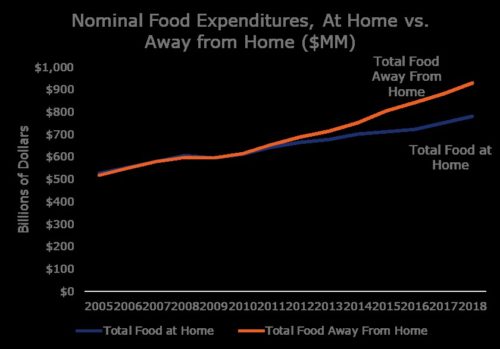
Figure 1: Jefferies USA April 2020
And then we had a pandemic. Restaurants shut down, most states issued shelter in place orders and improbably, we had a resurgence in food at home because, hey, it was the only option. Americans began cooking again, and there has been a surge in center store products like baking goods, fresh products (meat and produce) and canned foods. All of a sudden, our kitchens and our supermarkets were on trend.
For a period of time, this chart will likely remain inverted and there are estimates by the investment banker Jefferies that this trend could continue over the next 18 months. Health concerns, governmental regulations, and a recession could all come together to keep restaurant industry revenues suppressed with some estimates suggesting that 5-15% of restaurants will close due to the pandemic.
Seemingly great news for supermarkets but conditions are getting tougher there as well: restrictions have hampered supermarkets ability to sell prepared foods and bakery products, an important component of their sales mix and margins and e-commerce continues to rise, often at the expense of profitability.
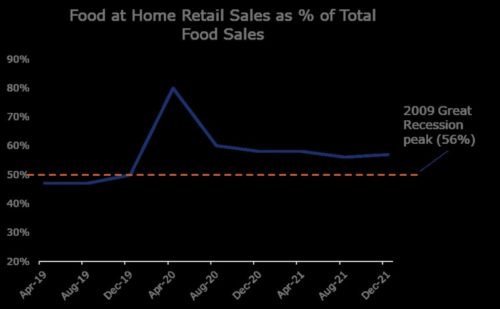
Figure 2: Jefferies USA April 2020
FAST: The Development Of The E-Store
As a result, both restaurants and food retailers will need to reinvent themselves and start thinking about the future. I collaborated with Natalie Shmulik, who is CEO of Chicago-based The Hatchery, a food and beverage incubator. As Natalie suggests, “while the food community is severely challenged, it is also an opportunity for innovation and reinvention”.
FAST is an acronym that helps describe and explain what future-proofing the food business might look like:
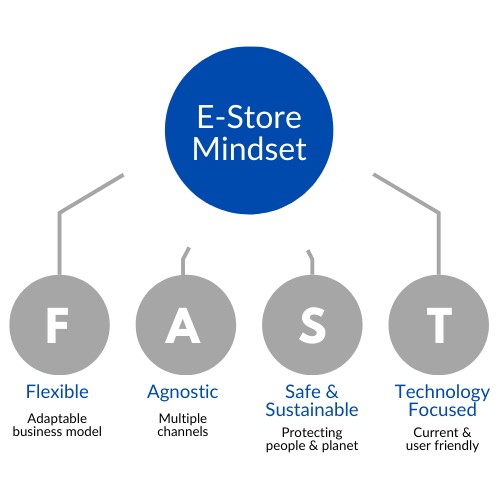
Figure 3: The E-store as demonstrated by the FAST acronym
Every industry is going to be thinking about future-proofing their business concepts, especially those who have physical spaces. This is a unique opportunity for architects and designers to start carefully thinking about how every square foot is used and why.
Natalie introduces the concept of the “E -Store” to demonstrate the principles of FAST. This new classification will force an immense amount of rethinking and innovation. She also correctly notes that while “the food industry is uniquely positioned, other brick and mortars will be taking note. Other industries will begin exploring how to transform their space utilizing E-store protocols and we are likely going to see more beauty shops, fitness centers etc… including food products and transforming into holistic marketplaces”.
The E-store mindset will shift how we build, design and use food spaces now and in future. Every company will be thinking about how they can continue to function if and when essential business restrictions are enforced again in the future, or, if consumer patterns continue to shift and adopt to new behaviors.
What are some examples of companies who are adopting FAST principles?:
Flexible
A major lesson of the pandemic is the need to be able to change your business model quickly. Whatever we think we know about the future, it will inevitably change. Being able to flex, quickly, is paramount.
Farmers Fridge. Chicago-based Farmers Fridge was already an innovator, bringing consumers healthy and fresh food through high tech vending machines at major traffic areas like airports and office buildings. Practically overnight, as demand in traditional venues slowed dramatically, the company shifted to catering (they’ve done a remarkable job of servicing health care workers in hospitals) and home delivery.
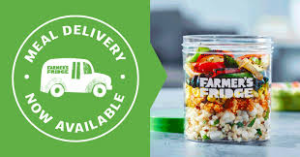
Figure 4: Farmers Fridge pivoted from airports and office buildings to hospitals and home delivery. Image Source: Farmer’s Fridge
Alinea Group. This heavily Michelin-starred restaurant chain (Alinea, Next, Roister) had a problem—with dining rooms closed and a restaurant concept that relies heavily on a high touch, high service experience. One of the founders is a pioneer in restaurant technology (Tock Reservations) and was able to shift to a To Go experience early in the pandemic. Remarkably, they are serving significantly more customers (10-20x the number of customers previously) at prices that are a fraction of the dine-in experience.
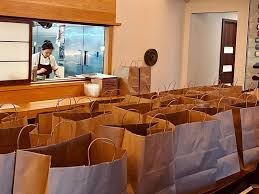
Figure 5: Alinea preps for takeout orders. Photo Credit: Ad Age
Agnostic
It should go without saying that being channel agnostic is a must have requirement for the future. For restaurants, this means lessening the reliance on any one channel (in-store dining, pick-up, delivery) and being able to build a flexible platform for consumer demand. For supermarkets, handling the surge in e-commerce requires a different type of fulfillment model than simply shopping in the aisles.
Raley’s. The Sacramento based grocery chain converted a closed unit to a “dark” store dedicated to e-commerce fulfillment. As e-commerce demand has risen 3-5x during the pandemic, in-store picking may no longer be the most viable solution to handle demand. Several other grocery retailers are employing robotic technology (micro-fulfillment centers) or adopting stores to become fulfillment centers. Amazon’s much anticipated first full grocery store in Woodland Hills has become a dark store as well.
Canlis. The Seattle institution went from a fine dining restaurant to creating a makeshift drive-thru, a bagel stand, and delivery of family meals. The homepage of their website says it all… In early March, we shut down our dining room. Fine dining is not what Seattle needs right now. Instead, we’re bringing the food to you. We’ve got this, Seattle.
Prairie. In San Francisco, Prairie converted their restaurant into a general store.
What will be interesting is how much of this continues when normalcy returns. It is quite likely that many of these business options will remain viable in the future—less in-store seating and more ways to pick up and deliver.
Safe & Sustainable. One of the unfortunate consequences of the pandemic is that there are seemingly conflicting positions. Grocery stores stopped allowing customers to bring in their own bags and loose product is now being packaged. This seems to work counter to the long growing trend of sustainability.
The Wally Shop. This online grocer features bulk products shipped in reusable packaging which the consumer sends back when they are done.
Forager. Forager connects farmers with retailers to facilitate buying local. One of the saddest aspects of the pandemic is the slowdown in demand in restaurants which has led to significant food waste. This service establishes local connections between farmers and retailers, driving more food sustainability and keeping food dollars within the community.
The Dorian. This San Francisco restaurant uses compostable takeout containers in paper bags without utensils (unless requested) to reduce plastic use and repurposes unused fruit and fruit rinds and dehydrates them to use as garnishes for cocktails. With delivery and pick-up continuing to grow, retailers are going to need to rethink their approach to being both safe and sustainable.
Technology Focused
Technology will be the great enabler to power all of the trends above. Companies will need to find new ways to profitably serve customers and allow for flexibility, channel diversification and safe and sustainable practices. This likely means new ways to ensure safety and new ways and partnerships to facilitate the future.
Robots that check aisles for out of stocks, unattended pick-up stations (lockers of all sorts), and micro-fulfillment centers to drive better picking and better technology to facilitate pick-up and delivery are going to become the norms. As will new standards for safety and security. Expect salad bars to go away (for now) and for our samples to be packaged.
Magnolia Bakery. A “cleanse portal” where customers stand under a UV light before entering the store has been installed at Magnolia Bakery.
Starbucks. Starbucks is rethinking its real estate strategy. Less in-store seating and more pick-up only locations facilitated by new technology. They have also partnered with Uber Eats to offer delivery.
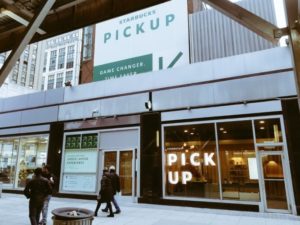
Figure 6: Pick-up is prominently featured at Starbucks. Photo Credit: Geek Wire
The future of food will look very different than it does today. Being FAST will be the only way to future proof the business.
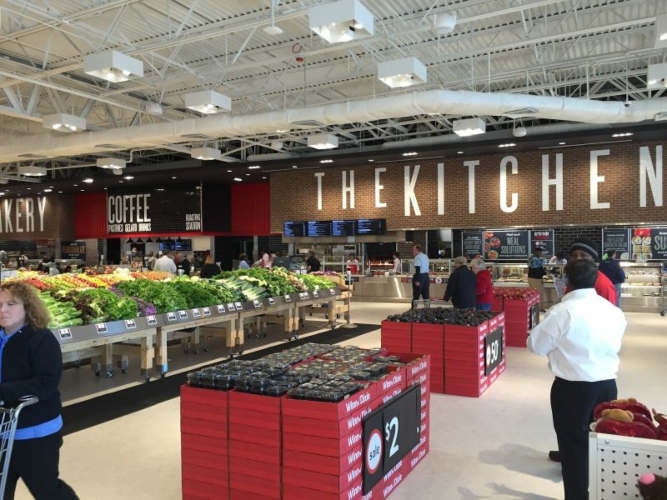
No Comments